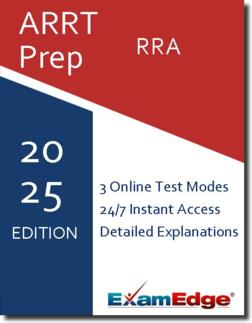ARRT® RRA (RRA) Practice Tests & Test Prep by Exam Edge - Topics
Based on 34 Reviews
- Real Exam Simulation: Timed questions and matching content build comfort for your ARRT RRA test day.
- Instant, 24/7 Access: Web-based ARRT Registered Radiologist Assistant practice exams with no software needed.
- Clear Explanations: Step-by-step answers and explanations for your ARRT exam to strengthen understanding.
- Boosted Confidence: Reduces anxiety and improves test-taking skills to ace your ARRT Registered Radiologist Assistant (RRA).

Understanding the exact breakdown of the ARRT Registered Radiologist Assistant test will help you know what to expect and how to most effectively prepare. The ARRT Registered Radiologist Assistant has multiple-choice questions The exam will be broken down into the sections below:
| ARRT Registered Radiologist Assistant Exam Blueprint | ||
|---|---|---|
| Domain Name | % | Number of Questions |
| Patient Communication, Assessment, and Management | 18% | 16 |
| Drugs and Contrast Materials | 15% | 13 |
| Anatomy, Physiology, and Pathophysiology | 26% | 23 |
| Radiologic Procedures | 19% | 17 |
| Radiation Safety, Radiation Biology, and Fluoroscopic Operation | 19% | 17 |
| Medical-Legal, Professional, and Governmental Standards | 8% | 7 |
| Case Studies | 4% | 4 |


